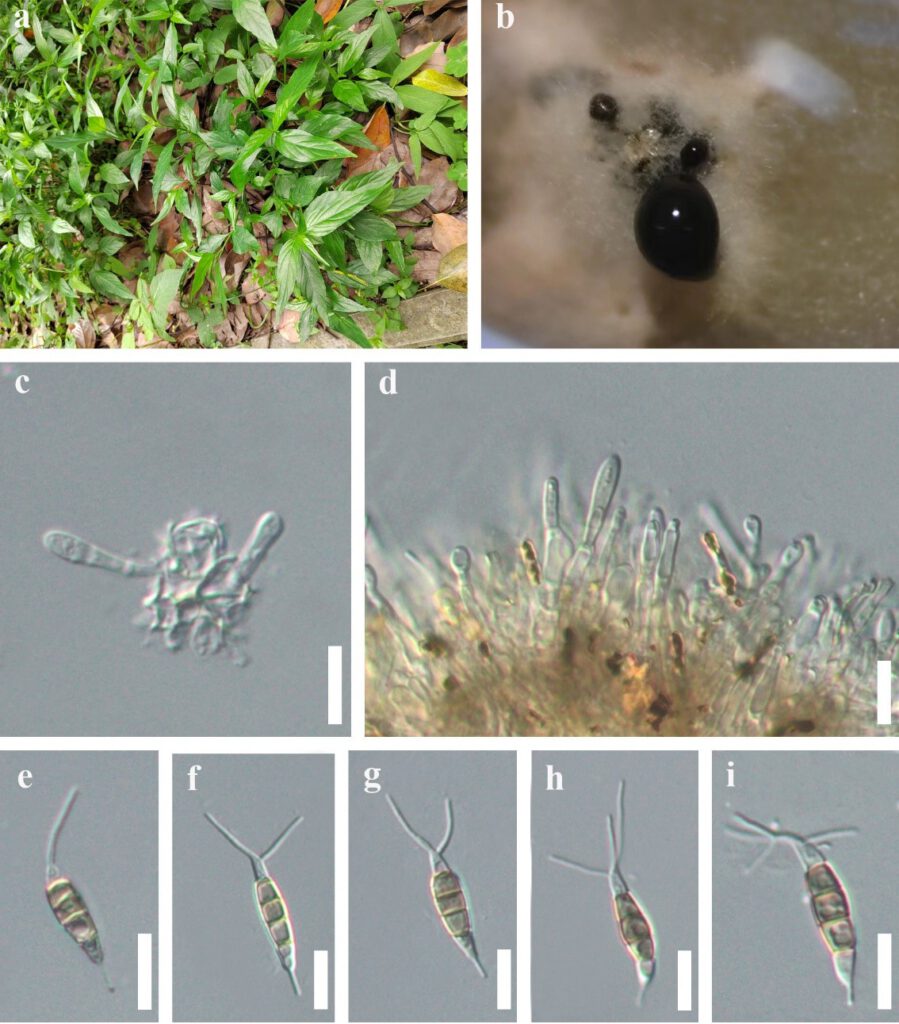Pestalotiopsis peristrophes Y.R. Sun & Yong Wang bis, sp. nov. Fig. 15
Index Fungorum number: IF; MycoBank number: MB; Facesoffungi number: FoF 12920
Etymology – Name reflects the host’s name, Peristrophe japonica
Holotype – HUGP 801
Endophytic from Peristrophe japonica. Colonies on PDA white with grey mycelia in the center, felty, black conidiomata, lobed edge; reverse white with pale to brown concentric circles. Sexual morph: Not observed. Asexual morph: Conidiomata on PDA pycnidial, solitary or aggregated, subglobose to globose, dark, semi-immersed or erumpent; exuding black conidial masses. Conidiophores hyaline, smooth, simple, reduced to conidiogenous cells. Conidiogenous cells 1.2–3.0 μm wide, cylindrical to sub-cylindrical or ampulliform to lageniform, hyaline, smooth. Conidia pale to brown, fusiform, straight to slightly curved, 4-septate, 20.0–29.0 × 4.5–6.2 μm, x̄ ± SD = 24.5 ± 2.0 × 5.2 ± 0.4 μm (n = 40), L/W ratio = 4.7; basal cell obconic with a truncate base, hyaline, smooth walled, 4.5–7.0 μm long (x̄ ± SD = 5.5 ± 0.6 μm); three median cells 12.0–17.0 μm long (x̄ ± SD = 14.0 ± 1.1 μm), pale to brown, wall rugose, septa darker than the rest of the cell, somewhat constricted at the septa; second cell from base pale to brown, 3.5–6.0 μm long (x̄ ± SD = 5.0 ± 0.4 μm); third cell pale to brown, 3.5–6.0 μm long (x̄ ± SD = 4.5 ± 0.4 μm); fourth cell pale to brown, 3.5–6.0 μm long (x̄ ± SD = 4.5 ± 0.5 μm); apical cell 2.7–5.7 μm long (x̄ ± SD = 4.0 ± 0.6 μm), hyaline, conic to acute; with 1–4 (mostly 2) tubular appendages on apical cell, inserted at different loci in a crest at the apex of the apical cell, unbranched, 7.5–17.5 μm long (x̄ ± SD =12.2 ± 2.5 μm); single basal appendage, unbranched, tubular, centric, 2.5–5.0 μm long (x̄ ± SD = 3.8 ± 0.5 μm).
Material examined – China, Guizhou Province, Guiyang City, Nanming District, Guiyang Medicinal Botanical Garden, on healthy leaves of Peristrophe japonica (Thunb.) Bremek. (Acanthaceae), 1 May 2022, Y.R. Sun, E53 (HUGP 801, died culture, holotype); ex-type living culture GUCC 803; China, Guizhou Province, Guiyang City, Nanming District, Guiyang Medicinal Botanical Garden, on healthy stems of Peristrophe japonica, 1 May 2022, Y.R. Sun, E56 (HUGP 802, dried culture, paratype; living culture GUCC 801).
Notes – An endophyte, P. peristrophes was isolated from the medicinal plant, Peristrophe japonica in China. Our four strains GUCC 801, GUCC 802, GUCC 803 and GUCC 804 clustered together and formed a distinct inner clade, which is sister to P. brachiata (LC 2988 and LC 8189) with strong support (ML-BS = 99%, BYBB = 1.00) in the phylogenetic tree (Fig 12). In morphology, P. peristrophes differs from P. brachiate by the numbers and size of the basal appendages (1 basal appendage, unbranched, 2.5–5.0 μm long in P. peristrophes vs. 1–4 basal appendages, branched or unbranched, 5.5–9.5 μm long in P. brachiate) (Liu et al. 2017). The PHI test on P. peristrophes revealed there is no significant recombination (Фw = 0.05827) between P. peristrophes and its closely related taxa (Fig 12c). Therefore, we introduce P. peristrophes as a new species.

Figure 15 – Pestalotiopsis peristrophes (HUGP 22-xx, Holotype). a Host. b Close up view of conidiomata, c, d Conidia attached to conidiogenous cells, e–i Conidia. Scale bars: c–i = 10 µm.
